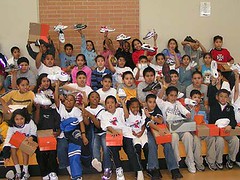Public assets: public school buildings used for more than school
 J.J. Pickle Elementary School image from the Shoes for Austin program.
J.J. Pickle Elementary School image from the Shoes for Austin program.This article from the Austin American-Statesman, "One-stop community: The challenge: Fill 5 needs for a Northeast Austin neighborhood; The result: A smart and innovative building that does it all," is pretty interesting:
That's because the 117,000-square-foot, $14 million building is not just a school. It's community fusion. A first-of-its-kind collaboration between the City of Austin and the Austin Independent School District, the building also houses a recreation center run by the city Parks and Recreation Department, a branch of the Austin Public Library, a neighborhood health center run by the city's Health and Human Services department and even a police neighborhood station. Although there are other shared-use public buildings in Texas, no other combines so many agencies...
Now bordered by Interstate 35 to the west and U.S. 183 to the north, the St. John neighborhood — with a history worthy of its own book — was once a distinct African American community nestled in rural outer Austin. The neighborhood has remained fairly intact over the decades — a perfect square hemmed in by modern highways and bordered by "big box" retail development.
Yet the area didn't benefit from Austin's growth. A municipal public health center occupied a small building, while other health services were operated out of a strip mall on the other side of the neighborhood. The original elementary school was closed when AISD embarked on a desegregation plan in the early 1970s and St. John schoolchildren were bused outside the neighborhood. A greenbelt running along Buttermilk Creek was often the scene of drug activity and other crime.
"Our children simply had nowhere to go," says Patricia Calhoun, a resident who, along with others, spent years lobbying city officials to bring services to their neighborhood. In 1996, an AISD bond issue included money for a new St. John elementary, and a 1998 municipal bond issue included monies for a recreation center, public library and public health center. Families might at last get what they needed without leaving the neighborhood. But just where was this all supposed to go?
Read the article and find out... Also see "Public School + YMCA + Community Center = Excited Nebraska City," from the Lincoln Journal Star, and "Schools cycle back into the heart of the neighborhood" from the Oregon School Board Association.
This is the kind of stuff that Superintendent Janey has been talking about, and I think it means he deserves time and support to pull it off. It's a vision, in a system that has lacked vision and in a community that seems to lack an understanding of the real problems that limit educational success.
To really deal with our education problem in DC, we must address poverty and the disconnection of families from educational and other socializing institutions. I think there are steps to take before the Mayor jumps in and takes over the school system.
After all, as a municipal government, while there are pockets of excellence here and there, I don't think it's proven that we have tremendous public administration capacity as it relates to the administration of all DC Government agencies.
I want to push the idea of a "First Day" Festival, if only in Ward 6 and the part of Ward 5 that abuts the ward, because there are some ANC commissioners and committee members in the area that can pull this off... See "Charleston's "First Day Festival" promotes commitment to and involvement in education." (Also see "As School Returns, Mayors Celebrate with Back to School Activities.")
According to Nation's Cities Weekly, in 2006:
The City of Charleston celebrated the beginning of the new school year with Mayor Joseph P. Riley Jr. hosting the fourth annual First Day Festival. The free event provided more than 8,000 parents, guardians and community members with information about student support services, free school supplies and a variety of food and entertainment. Nearly 100 businesses donated supplies to make the festival a success.
We can pilot this in NE for roll out to the rest of the city, and according to a list of grantees I saw in a recent issue of Chronicle of Philanthropy, the Staples Foundation for Learning would be a good target for funding...
Index Keywords: education



0 Comments:
Post a Comment
<< Home